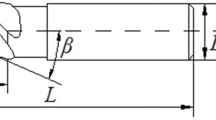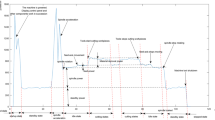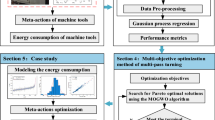Abstract
Cutting parameters and tool wear both have significant influence on energy consumption in the processing. In a multi-feature parts batch processing, tool wear values are continuously increasing with the proceeding of processing, leading to a higher energy consumption. To reduce the wear speed, cutting parameters should be continuously adjusted according to different states of tool wear during batch processing. However, current cutting parameter optimization studies only focus on one specific workpiece and the tool wear is seldom considered in the batch processing. To fill this research gap, a cutting parameter energy-saving optimization method considering tool wear for multi-feature parts batch processing was proposed in this paper. First, the synergistic effect mechanism of cutting parameters and tool wear on energy consumption in the batch processing was analyzed. On this basis, a multi-objective cutting parameter optimization model for multi-feature parts batch processing was established. Then, the multi-objective cuckoo search (MOCS) algorithm was used to solve the optimization model. Finally, an experimental case was carried out to verify the effectiveness and practicability of the proposed method. Results show that energy consumption and machining time can be, respectively, decreased by 22.9% and 4.1%. Meanwhile, a conflict relationship exists between the energy consumption and machining time in the processing and the trade-off of them is analyzed in this paper.












Similar content being viewed by others
Availability of data and material
The data needed to evaluate the conclusions in the study are included in this article.
Code availability
Not applicable.
References
Spiering T, Kohlitz S, Sundmaeker H, Herrmann C (2015) Energy efficiency benchmarking for injection moulding processes. Rob Comput Integr Manuf 36:45–59. https://doi.org/10.1016/j.rcim.2014.12.010
International Energy Agency (IEA) (2019) International energy outlook 2019. Retrieved 15 Mar 2021 from https://www.eia.gov/outlooks/ieo/pdf/ieo2019.pdf
Park CW, Kwon KS, Kim WB, Min BK, Park SJ, Sung IH, Yoon YS, Lee KS, Lee JH, Seok J (2009) Energy consumption reduction technology in manufacturing—a selective review of policies, standards, and research. Int J Precis Eng Manuf 10:151–173. https://doi.org/10.1007/s12541-009-0107-z
Xiao Q, Li C, Tang Y, Li L (2019) Meta-reinforcement learning of machining parameters for energy-efficient process control of flexible turning operations. IEEE Trans Autom Sci Eng 99:1–4. https://doi.org/10.1109/TASE.2019.2924444
Xie J, Cai W, Du Y, Tang Y, Tuo J (2021) Modelling approach for energy efficiency of machining system based on torque model and angular velocity. J Clean Prod 293:126249. https://doi.org/10.1016/j.jclepro.2021.126249
Gutowski T, Dahmus J, Thiriez A (2006) Electrical energy requirements for manufacturing processes. Proc CIRP Int Conf Life Cycle Eng 5–11
Zhao X, Li C, Chen X, Cui J, Cao B (2021) Data-driven cutting parameters optimization method in multiple configurations machining process for energy consumption and production time saving. Int J Precis Eng Manuf Green Technol 1–20. https://doi.org/10.1007/s40684-021-00373-0
Newman ST, Nassehi A, Imani-Asrai R, Dhokia V (2012) Energy efficient process planning for CNC machining. CIRP J Manuf Sci Technol 5:127–136. https://doi.org/10.1016/j.cirpj.2012.03.007
Hu L, Tang R, Cai W, Feng Y, Ma X (2019) Optimisation of cutting parameters for improving energy efficiency in machining process. Robot Comput Integr Manuf 59:406–416. https://doi.org/10.1016/j.rcim.2019.04.015
Li C, Xiao Q, Tang Y, Li L (2016) A method integrating Taguchi, RSM and MOPSO to CNC machining parameters optimization for energy saving. J Clean Prod 135:263–275. https://doi.org/10.1016/j.jclepro.2016.06.097
Bhushan RK (2013) Optimization of cutting parameters for minimizing power consumption and maximizing tool life during machining of Al alloy SiC particle composites. J Clean Prod 39:242–254. https://doi.org/10.1016/j.jclepro.2012.08.008
Cui X, Guo J (2018) Identification of the optimum cutting parameters in intermittent hard turning with specific cutting energy, damage equivalent stress, and surface roughness considered. Int J Adv Manuf Technol 96:4281–4293. https://doi.org/10.1007/s00170-018-1885-1
Chen X, Li C, Tang Y, Li L, Du Y, Li L (2019) Integrated optimization of cutting tool and cutting parameters in face milling for minimizing energy footprint and production time. Energy 175:1021–1037. https://doi.org/10.1016/j.energy.2019.02.157
Moreira LC, Li WD, Lu X, Fitzpatrick ME (2019) Energy-Efficient machining process analysis and optimisation based on BS EN24T alloy steel as case studies. Rob Comput Integr Manuf 58:1–12. https://doi.org/10.1016/j.rcim.2019.01.011
Zhang G, Guo C (2016) Modeling flank wear progression based on cutting force and energy prediction in turning process. Procedia Manuf 5:536–545. https://doi.org/10.1016/j.promfg.2016.08.044
Yoon HS, Lee JY, Kim MS, Ahn SH (2014) Empirical power-consumption model for material removal in three-axis milling. J Clean Prod 78:54–62. https://doi.org/10.1016/j.jclepro.2014.03.061
Tian C, Zhou G, Zhang J, Zhang C (2019) Optimization of cutting parameters considering tool wear conditions in low-carbon manufacturing environment. J Clean Prod 226:706–719. https://doi.org/10.1016/j.jclepro.2019.04.113
Zhou G, Yuan S, Lu Q, Xiao X (2018) A carbon emission quantitation model and experimental evaluation for machining process considering tool wear condition. Int J Adv Manuf Technol 98:565–577. https://doi.org/10.1007/s00170-018-2281-6
Bagaber SA, Yusoff AR (2017) Multi-objective optimization of cutting parameters to minimize power consumption in dry turning of stainless steel 316. J Clean Prod 157:30–46. https://doi.org/10.1016/j.jclepro.2017.03.231
Xie N, Zhou J, Zheng B (2018) Selection of optimum turning parameters based on cooperative optimization of minimum energy consumption and high surface quality. Procedia CIRP 72:1469–1474. https://doi.org/10.1016/j.procir.2018.03.099
Zhang X, Yu T, Dai Y, Qu S, Zhao J (2020) Energy consumption considering tool wear and optimization of cutting parameters in micro milling process. Int J Mech Sci 178:105628. https://doi.org/10.1016/j.ijmecsci.2020.105628
Wan T, Chen X, Li C, Tang Y (2018) An on-line tool wear monitoring method based on cutting power. IEEE Int Conf Autom Sci Eng 205–210. https://doi.org/10.1109/COASE.2018.8560412
Shi K, Zhang D, Liu N, Wang S, Ren J (2018) A novel energy consumption model for milling process considering tool wear progression. J Clean Prod 184:152–159. https://doi.org/10.1016/j.jclepro.2018.02.239
Wang P, Gao R (2016) Stochastic tool wear prediction for sustainable manufacturing. Procedia CIRP 48:236–241. https://doi.org/10.1016/j.procir.2016.03.101
Selvaraj DP, Chandramohan P, Mohanraj M (2014) Optimization of surface roughness, cutting force and tool wear of nitrogen alloyed duplex stainless steel in a dry turning process using Taguchi method. Measurement 49:205–215. https://doi.org/10.1016/j.measurement.2013.11.037
Liu Z, Guo Y, Sealy MP, Liu Z (2016) Energy consumption and process sustainability of hard milling with tool wear progression. J Mater Process Technol 229:305–312. https://doi.org/10.1016/j.jmatprotec.2015.09.032
Zhao G, Su Y, Zheng G, Zhao Y, Li C (2020) Tool tip cutting specific energy prediction model and the influence of machining parameters and tool wear in milling. P I Mech Eng B-J Eng 234:1346–1354. https://doi.org/10.1177/0954405420911298
Priarone PC, Robiglio M, Settineri L, Tebaldo V (2016) Modelling of specific energy requirements in machining as a function of tool and lubricoolant usage. CIRP Ann 65:25–28. https://doi.org/10.1016/j.cirp.2016.04.108
Albertelli P (2017) Energy saving opportunities in direct drive machine tool spindles. J Clean Prod 165:855–873. https://doi.org/10.1016/j.jclepro.2017.07.175
Mellal MA, Williams EJ (2014) Cuckoo optimization algorithm for unit production cost in multi-pass turning operations. Int J Adv Manuf Technol 76:647–656. https://doi.org/10.1007/s00170-014-6309-2
Zamani AA, Tavakoli S, Etedali S (2017) Fractional order PID control design for semi-active control of smart base-isolated structures: a multi-objective cuckoo search approach. Isa Trans 67:222–232. https://doi.org/10.1016/j.isatra.2017.01.012
Yang XS, Deb S (2009) Cuckoo search via Levy flights. World Congr Nature Biol Inspired Comput NaBIC 210–214. https://doi.org/10.1109/NABIC.2009.5393690
Arriaza OV, Kim DW, Lee DY, Suhaimi MA (2017) Trade-off analysis between machining time and energy consumption in impeller NC machining. Rob Comput Integr Manuf 43:164–170. https://doi.org/10.1016/j.rcim.2015.09.014
Wang W, Tian G, Yuan G, Pham DT (2021) Energy-time tradeoffs for remanufacturing system scheduling using an invasive weed optimization algorithm. J Intell Manuf 1–19. https://doi.org/10.1007/s10845-021-01837-5
Funding
This work was supported in part by the National Key R&D Program of China (No.2019YFB1706103), National Natural Science Foundation of China (No.51975075) and Chongqing Technology Innovation and Application Program (No. cstc2020jscx-msxmX0221).
Author information
Authors and Affiliations
Contributions
Congbo Li and Shaoqing Wu designed the work, performed the research and analyzed the data. Congbo Li, Shaoqing Wu and Qian Yi discussed the results and wrote the manuscript. All authors contributed to conducting experiment, drafting and revising the manuscript.
Corresponding author
Ethics declarations
Ethics approval
Not applicable.
Consent to participate
Not applicable.
Consent to publish
Not applicable.
Conflict of interest
The authors declare that they have no competing interests.
Additional information
Publisher's Note
Springer Nature remains neutral with regard to jurisdictional claims in published maps and institutional affiliations.
Rights and permissions
About this article
Cite this article
Li, C., Wu, S., Yi, Q. et al. A cutting parameter energy-saving optimization method considering tool wear for multi-feature parts batch processing. Int J Adv Manuf Technol 121, 4941–4960 (2022). https://doi.org/10.1007/s00170-022-09557-7
Received:
Accepted:
Published:
Issue Date:
DOI: https://doi.org/10.1007/s00170-022-09557-7




